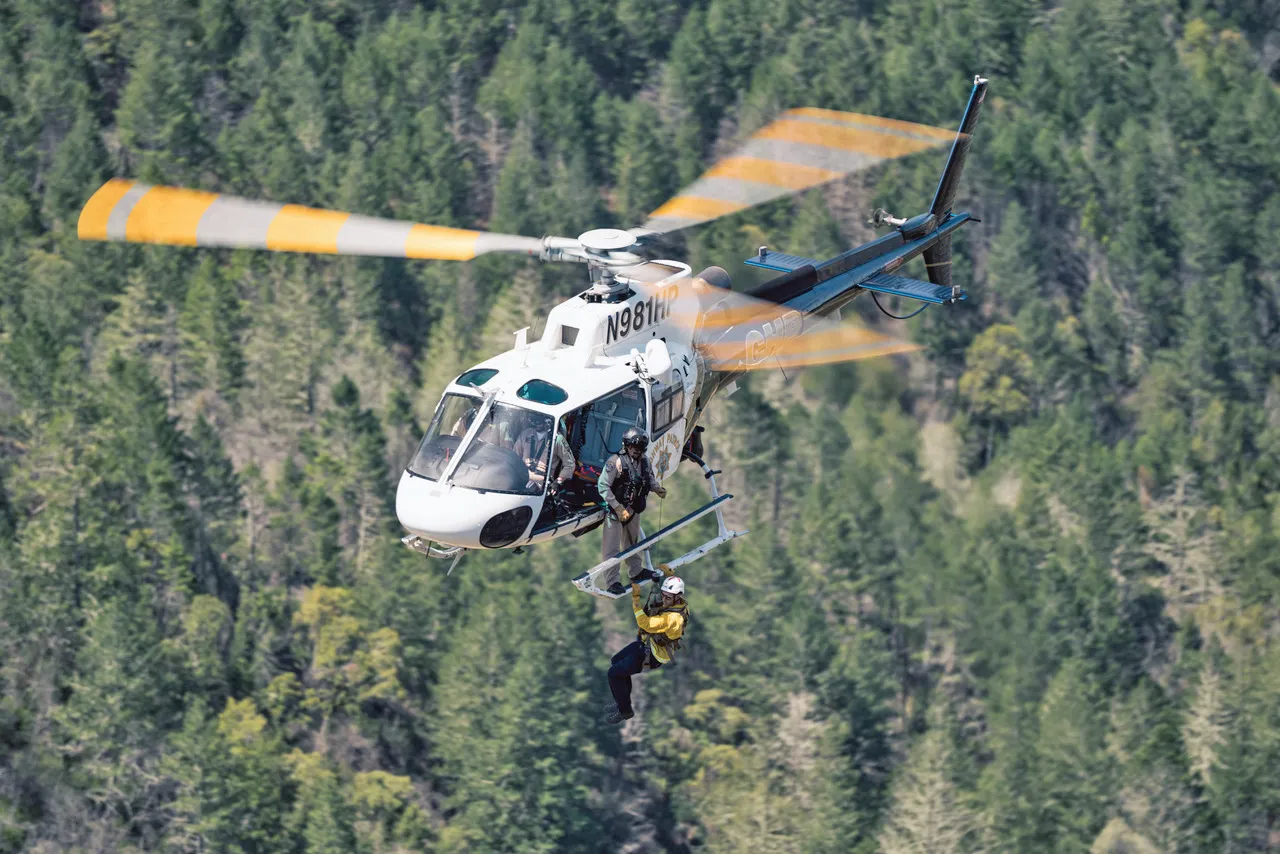In the past two years, an inter-agency rescue operation involving California Highway Patrol’s Air Operations and the Calistoga Fire Department has taken off, so to speak.
The Helicopter Rescue Technician (HRT) program originated in the Sierra Nevadas where there was a high need for specialized technicians to assist in rescues in the rugged terrain, said Shaun Bouyea, CHP’s Napa Air Operation Unit spokesperson. The program has since expanded, and to date, CHP’s Golden Gate Division has teamed up with six Bay Area fire departments chosen for their geographical proximity to high-volume call areas.
“It’s mutually beneficial for the fire departments and for us,” Bouyea said. “The reason we have Calistoga is geographically, you have Table Rock and Mount St. Helena, which traditionally gets a high volume of rescues and it’s nice to have highly trained firefighters familiar with the terrain in that area.”
After the onset of the COVID-19 pandemic, there was a spike in the number of people who needed medical assistance. Which is why, in 2022, CHP chose Calistoga Fire as one of the agencies it would team up with to aid hikers, bikers and rock climbers who find themselves in need of assistance on the trails in the area.
“People are going out and enjoying the outdoors, but they're also getting hurt while they do it,” Bouyea said. “Prior to COVID, there were a significant amount of rescues, but not a high volume. Once COVID hit, throughout the Bay Area, our call volume for rescues went through the roof.”
The other five Bay Area fire departments CHP works with on these rescue missions include San Francisco, North County, San Ramon Valley, El Cerrito and Marin County.
Especially in the spring and summer months, when people take advantage of the warm weather and mountainous terrain surrounding Calistoga, every so often, people get lost or succumb to falls, heat stroke or dehydration.
“Highway Patrol, we have the helicopter and we have the night vision (FLIR); we have the hoist, we have paramedics on board, so we can effect the rescue fairly quickly,” Bouyea said. “Our Achilles heel is we need a third rider – a third person to ride the hook; and that fits in perfectly for Calistoga Fire because they have the ground personnel that we can insert without them having to hike a mile or two, three miles to the scene.”
When it comes to the mountainside rescues, agencies find helicopters are the most efficient mode of transportation to bring hikers to safety quickly and with the fewest people and equipment – but it’s certainly not the least expensive approach.
Bouyea noted that CHP doesn't charge patients for the air rescues and for medical transport – which would cost tens of thousands of dollars – nor does it bill patients’ insurance policies.
“It’s just a service that we provide to the public,” he said.
Prior to joining the HRT team, Calistoga Fire Chief Jed Matcham said the agency was dispatched four times in 2021 and three times in 2022 to assist in nearby trail rescues by fire truck. In 2023, the first full year Calistoga joined the HRT program, the agency aided in rescues by helicopter, and the numbers doubled. Matcham said he expects the Calistoga Fire’s dispatch frequency to assist in incidents of this nature will increase again this year.
Most recently on July 30, CHP and Calistoga Fire united to rescue a hiker four miles from the Table Rock trailhead and transported the individual to a local hospital for treatment.
For the rescues, CHP’s Air Operation agents fly from their Napa base to the Fairgrounds property – where the chopper lands, picks up the ready-to-go Calistoga/HRT-trained fire fighter, and flies to the individual in distress.
Calistoga Fire Captain Jeremy Campbell is one of six department firefighters trained in the program, which requires an initial course and additional training sessions every three months.
“We become basically the third body on that helicopter,” Campbell said. “Our role is to be lowered down on a hoist mechanism to where the patient is. Then we have a couple of different scenarios that require different equipment for a rescue.”
After a rescue, the helicopter pilot usually drops the firefighter back at the fairgrounds where an ambulance is also waiting to pick up the patient and transport them to a medical facility, if needed. For a serious injury though, the chopper can fly the patient to closest trauma center.
While the team is trained to encounter all kinds of scenarios and medical traumas, most rescues, Campbell said, involve “slips, trips and falls,” that cause ankle injuries, as well as cases of dehydration or lost hikers.
“The Oat Hill Mine Trail, The Palisades, Table Rock and Mount St. Helena – those are all pretty popular destinations for people to come from out of the area to go hiking or rock climbing and mountain biking; same for the local community – there are a lot of people that like to use those trails,” Campbell said.
To steer clear of risk in the first place, he suggested trail-goers wear appropriate shoes, bring water and familiarize themselves with the terrain ahead of time.
While Calistoga Fire is available primarily for local rescues, the firefighters sometimes assist CHP with rescues in Pope Valley and Lake County as well.
“We can be a resource to CHP wherever they need to go,” Campbell said.
Correction: A previous version of this story that ran in the Calistoga Tribune incorrectly identified the number of helicopter rescues Calistoga Fire was involved with in 2021 and 2022. The partnership began in late 2022.





